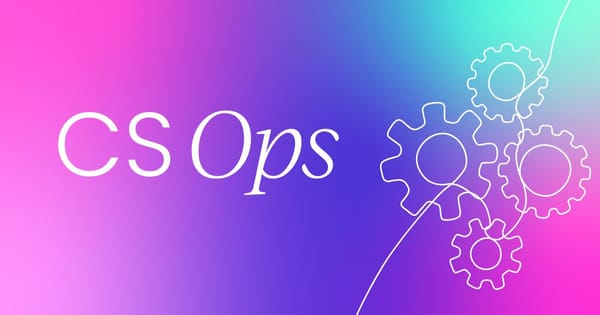What is customer success operations?
Customer success operations is a role that organizes and streamlines a customer success team. "Operations management" is a function in and of itself, and it’s emerging across all fields – from marketing to sales.
CS Ops is responsible for coordinating, actioning and analyzing the structures in place within a customer success team. It's fundamentally about reinventing the customer experience, establishing foundational pillars within an organization to meet and exceed customer expectations.
CS Ops ensures the customer has a seamless experience and facilitates a frictionless renewal process. CS Ops today is similar to what customer success today, was about ten years ago.
An operations team is critical for any business scaling, helping provide it with stability and direction. But why should you hire a customer success operations role? The simplest answer: it drives productivity and strengthens customer relationships.
Why every growing customer success team needs operations
At its core, customer success is an innately forward-thinking function, aiming to remove barriers between the customer and product. Clear, efficient and smooth processes are therefore mandatory.
According to the State of Customer Success 2024 Report, the most common internal barriers facing CS teams are a lack of resources, budget constraints, and poor collaboration with product teams — exactly the challenges a strong CS Ops function helps overcome.
"As gross and net revenue retention become a big focus area for all sorts of organizations, building in an operational infrastructure behind a powerful CS team lets the company drive positive outcomes," explains Phil Kowalski, Customer Success Strategy and Operations at HubSpot.
This operational infrastructure takes the form of customer success operations. A CS Ops Manager has the mission of driving productivity, consistency, efficiency, and scale across CS organizations. These goals manifest in managing the processes, tools, customer health scores, reporting, and new initiatives for CS teams.
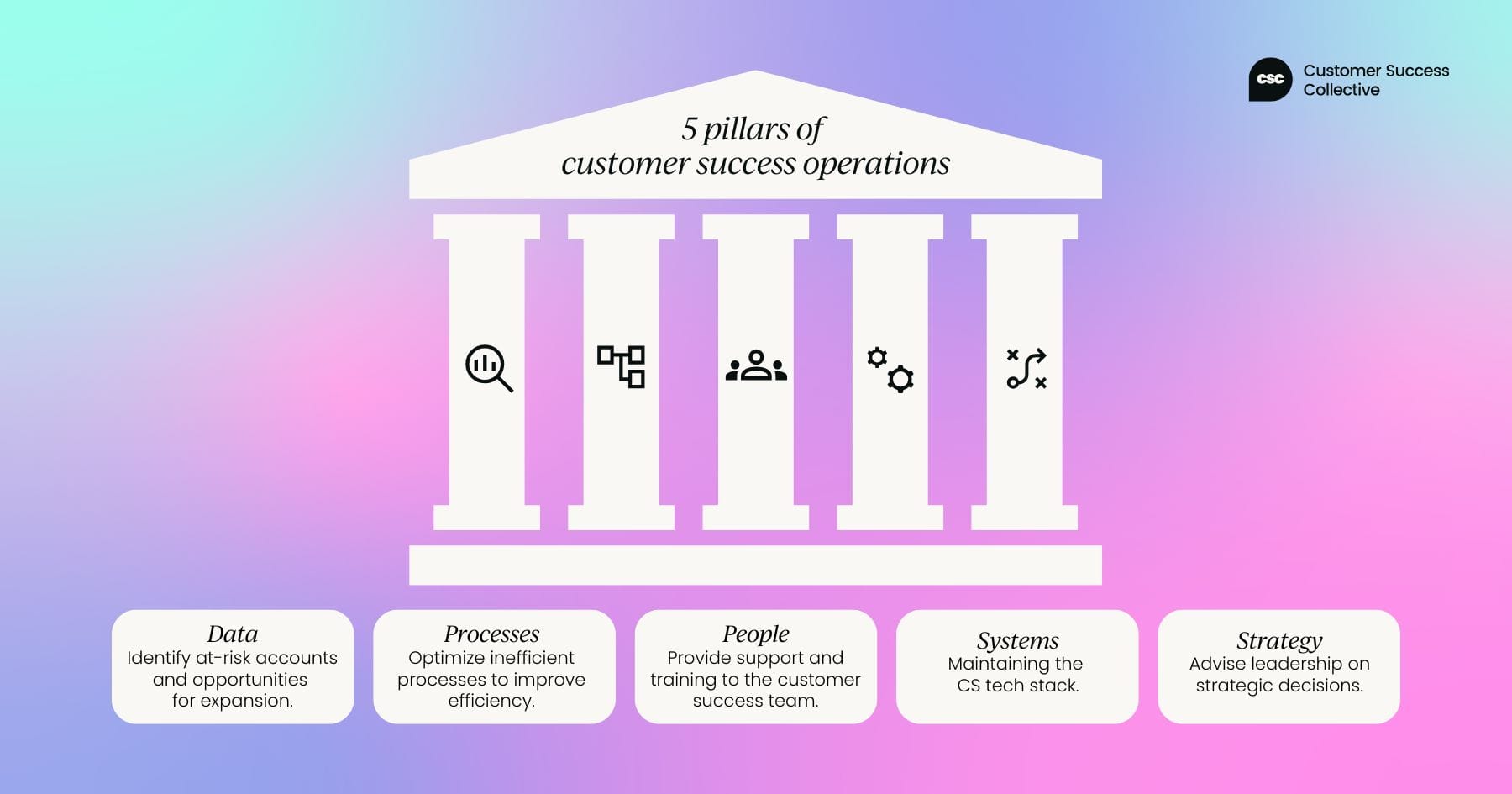
A great example of why CS Ops is essential is its ability to establish foundational pillars to meet and exceed expectations, delivering an optimized customer engagement model.
For Roger Mendez, Global Leader of Strategic Programs in CS and Acceleration at Cisco:
"CS Ops is fundamentally about reinventing the customer experience. It establishes foundational pillars within an organization to meet and exceed customer expectations. Ops ensures the customer has a seamless experience and facilitates a frictionless renewal process."
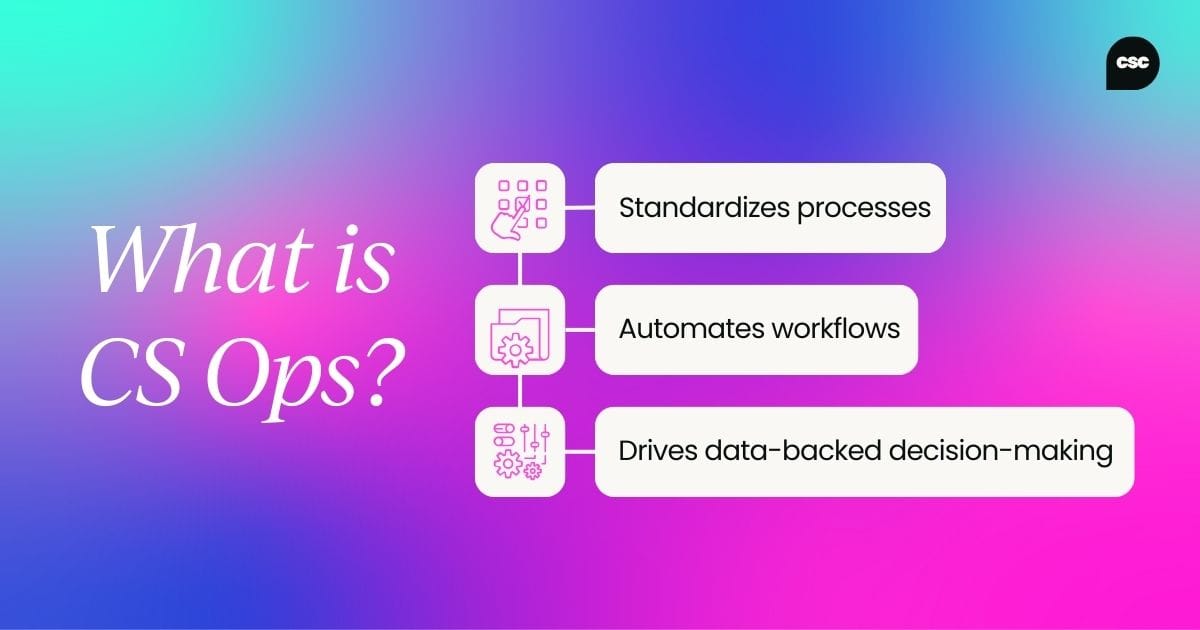
The CS Ops role is a key enabler for team growth, helping support everything from product adoption to cross-functional alignment. According to Adam Schifferli, Client Experience Officer at Checkwriters:
"One of enablement, sales and marketing organizations have been doing this for a long time. Essentially it's the question and answer for scalability, as well as a tighter integration along the entire revenue channel – from first marketing touch, through implementation and adoption, and heading into renewals and growth."
How common is CS Ops today?
As customer success managers grow in importance, organizations are recognizing the need for dedicated roles and teams to support and optimize their customer success operations.
Based on the data provided, a slight majority (55.3%) of organizations have a dedicated Ops function, while 44.7% don’t have such a role.
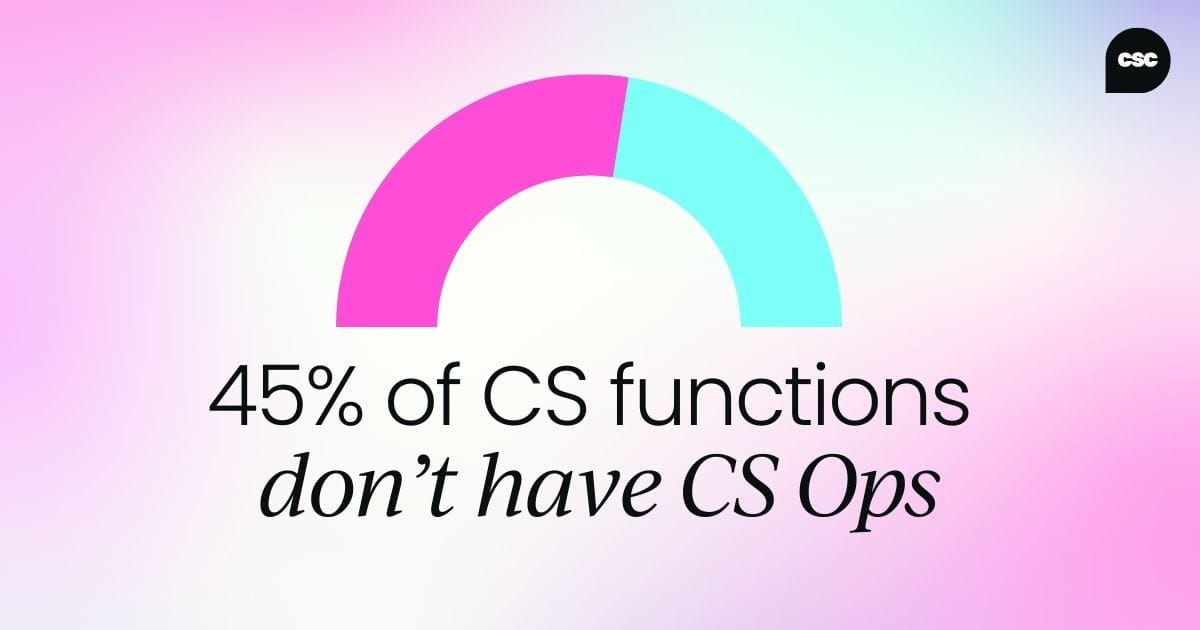
We wanted to know just how prevalent the CS Ops role is in businesses. In our State of Customer Success Report 2024, we discovered there's been a 21% rise in CS Ops in businesses.
It's worth noting that with this rise in CS Ops, we've also seen that 49.1% of CS professionals are now responsible for account expansion activities like upsells, cross-sells, and renewals, further highlighting the growing need for operational support to manage and streamline these complex processes.
This split in responses suggests that adopting a CS Ops role is becoming increasingly common. However, a significant portion of organizations still have not yet established this function.
Maybe you’re in the operations business already and are looking to branch out into customer success. Perhaps you’re looking to make your first CS Ops hire. Whatever your interest, if you’re new to this job function, it’s worth us ironing out what exactly a Customer Success Operations Manager does.
What does a Customer Success Operations Manager actually do?
Promoting cohesion is the principal responsibility of a CS Ops Manager, ensuring every CSM is united toward their organization’s overarching goals.
But the day-to-day role of a CS Ops Manager will depend on the maturity of your customer success function.
If your CS function is brand new, a CS Ops Manager may have to develop processes from scratch – we're talking from reporting processes to strategies that drive customer satisfaction.
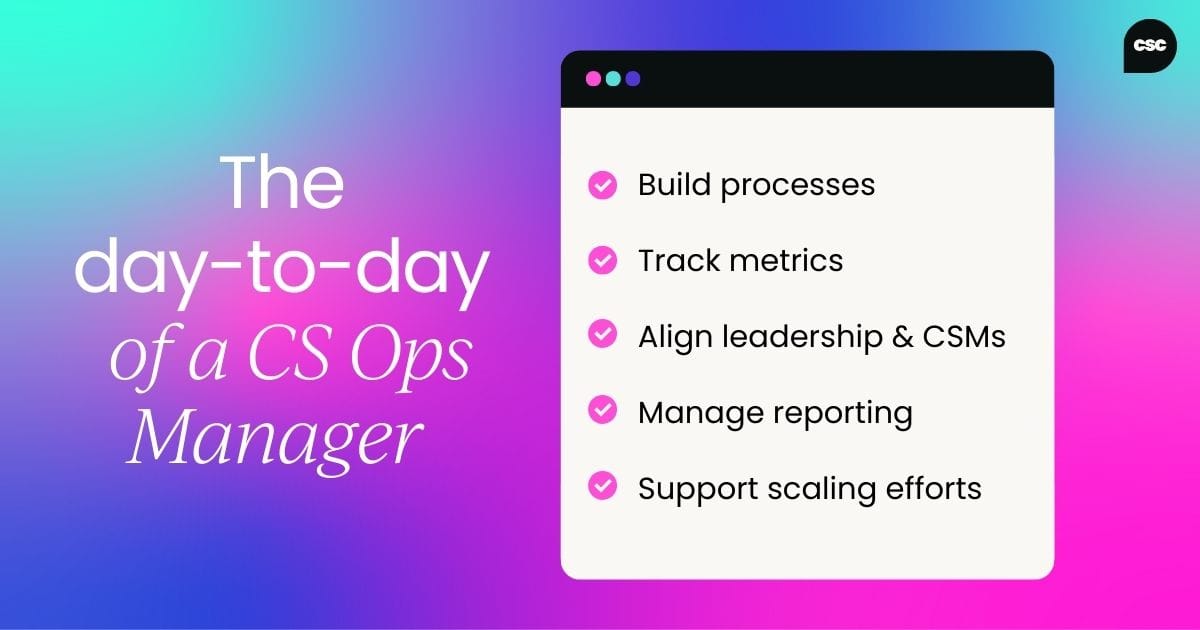
This role ensures accuracy in metrics, like upsell and cross-sell opportunities, and aligns the VP of Customer Success with the team.
Above all else, ownership is the key to success in this job – without it, the ability to effectively carry out customer success strategies will eventually run to a halt.
Having a Customer Success Operations Manager within your ranks means that someone is responsible for the changes and overarching organization necessary to keep your organization's CS function ticking over.
The power of data analysis in customer success operations
If an organization is expanding its customer success team, there’s a greater demand to analyze customer data and base all decisions on this data.
Data is essential to interpret customer engagement and guide business decisions. A smart way to tackle this is by tracking both internal metrics, like churn rate and health scores, and external customer data from surveys.
In fact, 64% of CS teams now track churn rate and 57.9% measure account retention rate (up nearly 40% year-over-year), showing how central data analytics have become in customer success — and how critical CS Ops is to support that.
Where internal data allows leaders to identify at-risk customers and trends to present to senior leadership, external data provides a window into the voice of the customer. Are they satisfied? Which features do they use? What can be improved?
Combining internal and external data sources gives you a multidimensional view of customer health and opportunities, and lets your senior leadership (your Director of Customer Success/VP of Customer Success/Chief Customer Officer) focus on proactive retention and experience.
If you're wondering, here are four primary data sources to pick from:
- Product usage metrics
- CRM interactions
- Financial performance
- Third-party information
But a word of caution: you must beware of inconsistencies and information overload. The key here is transforming raw data points into meaningful insights, i.e., identifying opportunities for renewal and expansion.
Data analysis and outcomes
The real key is transforming this data into measurable outcomes that demonstrate value.
How can CS Ops aid this quest? By equating platform activity metrics with internal process improvements and cost savings. When you quantify value in this way, you strengthen any potential renewal conversations. Because that's what data should do: it shouldn't be the conversation, it should inform conversations.
With the deluge of data in today's landscape, customer success leaders must stay vigilant to focus their teams and demonstrate value through data-driven insights. And having crystal clear processes is where CS Ops sings.

When (and why) you should hire for CS Ops
When it comes down to broadening your team, you should always make sure the utility of the CS function is the real reason for recruitment.
There isn’t much point in investing in a salary that isn’t needed just yet, otherwise, you’ll be throwing money down the drain. And if your customer success team is still in its infancy, with only 1-2 CSMs, you won’t have much to organize and streamline yet.

You should consider investing in a CS Ops role once your customer success team reaches around five or more CSMs. As your team scales past 10, a junior hire, like a Customer Success Operations Assistant, can further support operational needs.
This growth inflection point is echoed by Adam Schifferli, Client Experience Officer at Checkwriters:
‘The CS ops role begins to make more and more sense as teams try to adjust to a lower touch cadence strategy, as the ICP begins to emerge from data, or a RevOps strategy is adopted. Different drivers for the same cause, answering the question of how to enable current state teams to deliver higher and repeatable results with scalable elegance.’
Phil Kowalski, Manager of CS Strategy & Ops at HubSpot, also advocates for early planning:
"CS Operations should be someone's responsibility from the day a company has their second customer. It obviously shouldn't be someone's full time job at that point, but it should be something someone at the org is thinking about and building towards i.e. how to build repeatable processes to deliver great engagement and retention.
"I'd advocate bringing it in as a full time role ASAP, as it pays dividends down the line – this is especially if the CS team is growing and scaling.
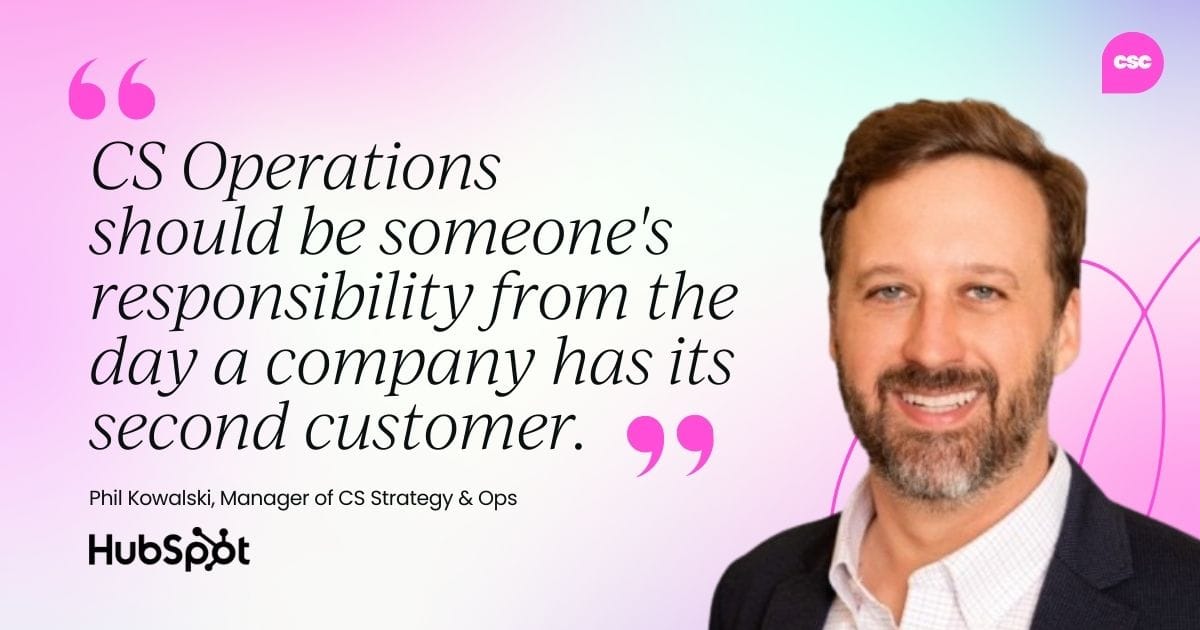
"Having solid tools and processes greases the wheels on bringing in new employees to the organization, so new CSMs can focus on what they do best.
"Oftentimes some of the operations work can fall on the leader of the CS team, so offloading that to an operations role can let CS leadership focus on more strategic initiatives to push the team forward vs. managing more tactical updates."
As teams grow, so do their operational complexities. And given that the average CS leader today manages between 3-8 CSMs (State of Customer Success 2024), investing in CS Ops early can make the difference between scalable success and growing pains.
The effect of CS Ops
The essence of the CS Ops role is to relieve the customer success team of the burden of general administrative tasks in a way that streamlines operations within CS, and prevents a breakdown in communication as the team grows. After all, customer success leadership should be tasked with just that: to lead their team.
By alleviating the rest of the CS team from the more mundane tasks of processes and managing data systems, they have the time to properly address their own tasks at hand. In other words, customer success operations seamlessly support the rest of the team as it scales up.
Without CS Ops, the administrative load can be overwhelming, especially since only 36.4% of CS professionals receive commissions for revenue growth, despite nearly half being tasked with driving it. Freeing CSMs from operational burdens lets them focus on high-impact relationship-building work.
As Phil Kowalski, Manager, Customer Success Strategy & Operations at Hubspot, puts it:
"CS Ops is a CSM's dearest friend! By making useful insights immediately available, automating lower value tasks, and leveraging more data at scale, the operations function allows the CSM to focus more on the things that only a human can do who is well aware of their customer’s goals and initiatives."
For Adam Schifferli, Client Experience Officer at Checkwriters:
"The rise in CS Ops correlates with the increased importance in viewing customer success as a revenue-generating function. With more value placed on the customer success mission, organizations create a strong backbone through CS operations, enabling each CSM and CS leader to be better at their job."
So, we’ve covered how CS Ops can impact the customer success team, but does it impact the wider organization? If so, how?
The hidden impact of CS Ops on business growth
We’ve all heard of the "Butterfly Effect" – the theoretical concept that the smallest movement can bring about monumental change; the same can be said of implementing new positions within an organization – no matter how small, they will have a knock-on effect on a larger scale.
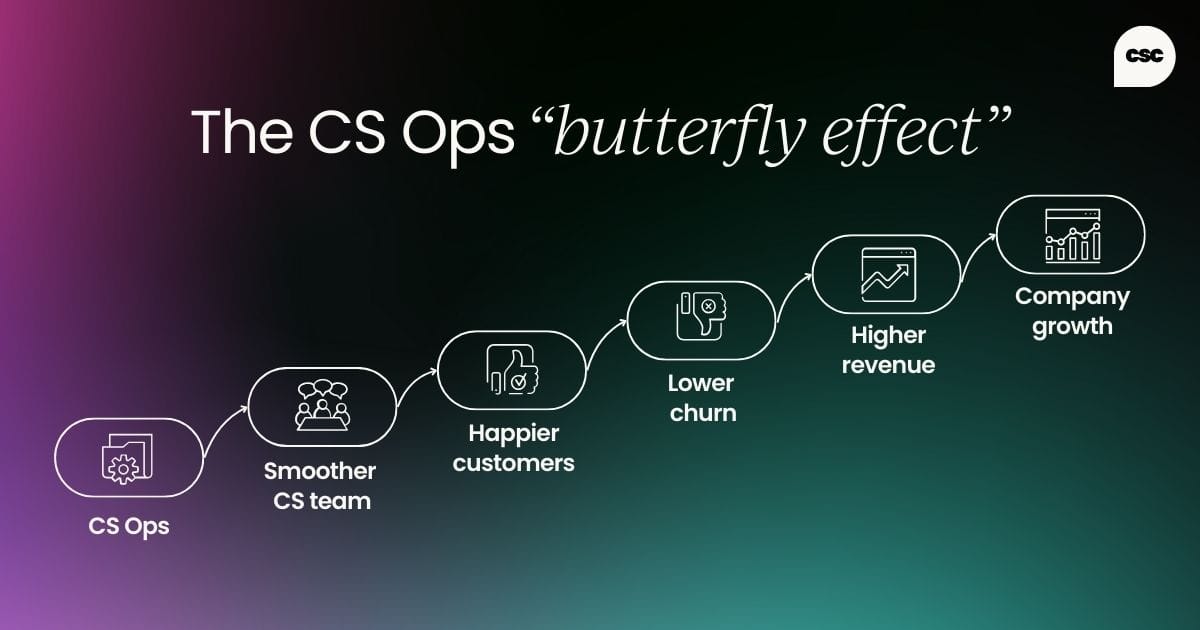
Having a well-supported, highly-functioning customer success team at the behest of a Customer Success Operations Manager, means that the customers will have the full attention of the CS team, enabling them to fulfill their goals. A successful CS team will reduce churn rates, promote customer retention and generate a greater sense of customer satisfaction.
In terms of how CS Ops impacts businesses as a whole: one thing to consider is how CS Ops interacts with other operations groups on other functions. There's a debate on where CS Ops employees should report into – a CS leader or a centralized operations leader, and I can see either working depending on the organization.
Phil Kowalski highlights the importance of cross-functional alignment:
"I think the biggest thing to consider though is that a CS Operations should be strongly connected to other operations employees within other functional groups. This is important to make sure initiatives are aligned - oftentimes in overlapping systems - throughout marketing, sales, and CS.
Phil warns that this misalignment of Ops groups can lead to duplicative and/or contradictory efforts, wasting valuable resources:
"With more and more emphasis placed on delivering strong customer experiences, having a strong connection to and from CS Operations to the rest of the org will help fuel overall growth."
The development of CS Ops is like the "advent of the train in an era of the horse and buggy," according to Adam Schifferli. In Adam's words, CS Ops can be a true catalyst, and with it, opens a new world of possibilities:
"CS Ops allows us to be more reliabile, more predictabile, and offers stronger cross-functional insights to further conversations and development with marketing, sales, and product.
"It's in that central place that customer success is traditionally at it’s best, and with the support of strong operations their work becomes far more powerful for the direct customer as well as the entire organization."

The "lean-in" model of customer success operations
CSMs must embrace uncertainty to create value, like mapping company values to stakeholders' needs and phasing rollouts.
When Chief Tech Officers or executives dump overwhelming requests and data on CSMs, they can follow a process set by CS Ops so they don’t freeze up:
- Set realistic a scope and resources
- Map needs to company values
- Analyze data methodically
- Set smart goals
- Build phased rollout plans
Even complex data becomes manageable by segmenting, so you can identify the first opportunity and a 90-day plan. But tactical “field” skills around customer program execution can only take CSMs so far.
To lead world-class CS orgs, you also need “off-field” skills – building trusted relationships and collaborating with your peers across business units. Dynamic companies have CS leaders with equal field execution and relationship-building skills to accelerate renewals and customer value.
Those core leadership skills let you foster shared beliefs around customer centricity across your company. When CSMs lean in and nimbly build networks and allies across orgs – in product, services and marketing – that “off the field” foundation results in powerful “on the field” outcomes for customers, showing the tangible value their CS leaders provide.
Tactical skills can be taught – the innate drive to constantly learn, build trust, challenge yourself, and empower organizations around the customer cannot. Master both and you’ll lift your career and company to new heights.
How to build an elite customer success team with CS Ops
Your customer success team is the heart of the customer experience. Building a skilled and collaborative group that drives loyalty and growth starts with hiring the right people – those with domain expertise, emotional intelligence, and a passion for customers.
Create an inclusive process that identifies team players oozing with empathy. Immerse them in the vision to make customer-centricity the norm. Ensure diversity of perspectives and backgrounds so your team can relate to all customer types. Routinely check success metrics and be ready to pivot approaches based on the data.

Getting leadership buy-in for major customer success transformations is also key. Evolve the team in lockstep with company growth. When proposing organizational shakeups, forecast results and get key stakeholders on board.
With the proper structures and culture in place, your customer success team can forge enduring customer bonds, provide product insights, and lift the business. But it requires intention and investment because this customer-obsessed unit is the face of your company.
Why CS Ops is a must
All in all, the role of customer success operations is one that is a definite must for a fast-growing customer success team.
Without this level of support for administrative tasks and to streamline processes, fractures might begin to appear and lead to an eventual breakdown of communication and overwhelm the CS team.
And when making the case of CS Ops to leadership? The role allows CSMs and leadership to focus on their tasks at hand, aiding productivity.
Looking for an even deeper understanding of CS Ops?
Have you ever thought about setting up a customer success team of your own?
We have the perfect course to help you position CS to a leadership team and establish a successful customer success operation.
Introducing... Building a Customer Success Team Certified: Masters.
By taking this course, you'll discover how to:
🔧 Leverage technology and automation to streamline customer success operations and improve efficiency.
🧑🎨 Sculpt out a strong CS function and learn for your business, including where CS slots into the client experience and why it’s an investment for the future.
🎨 Create effective customer onboarding processes and ensure a seamless transition from sales to customer success that sets the stage for long-term relationships.
🧱 Build a culture of continuous improvement by cultivating a mindset of learning and growth within your customer success team



 Follow us on LinkedIn
Follow us on LinkedIn


